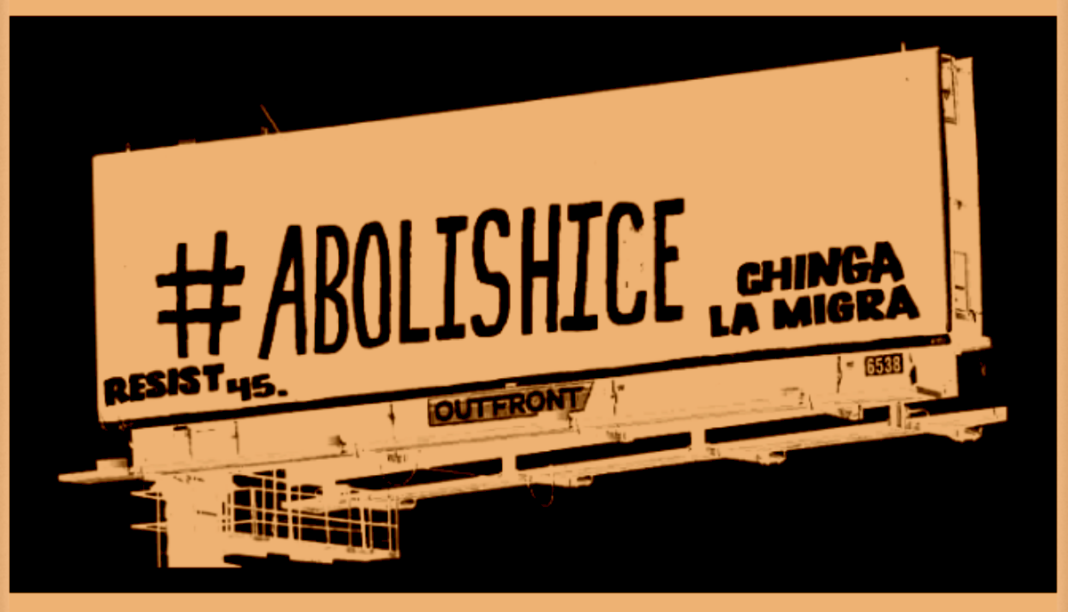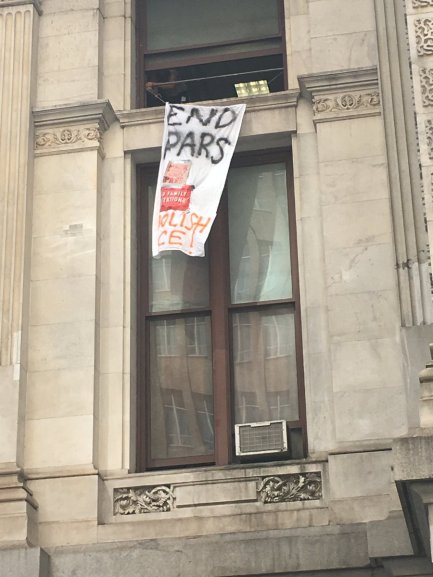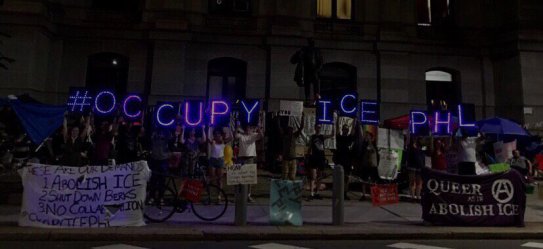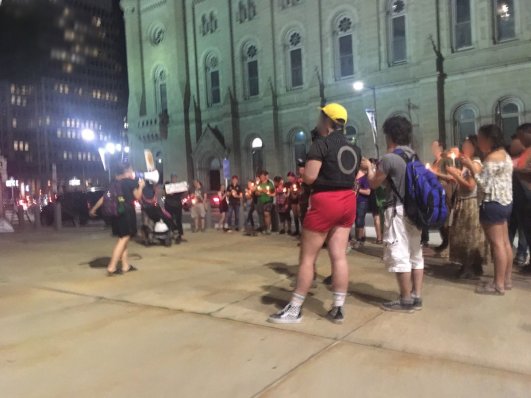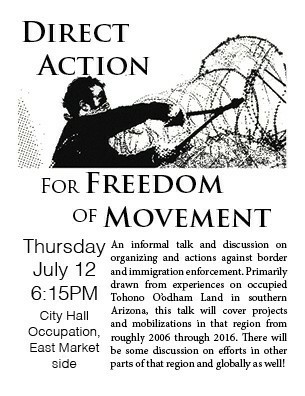from It’s Going Down
The following is the introduction to Vol. 1 of the new zine Rebellion and Possibility: Voices in the Anti-ICE Struggle. Vol. 1 of the zine can be found here. Vol. 2 will be released shortly.
Download Booklet HERE
“COMBINE, INTENSIFY, FEDERATE: Radical struggle and the anti-ICE movement”
By Redrick of the Radical Education Department
0. Overview
The nationwide rebellion against ICE is a pivotal moment in American radical struggle. It burst forth as part of a historic, massive wave of revolt that has been shaking the US for the past year and a half.
But the anti-ICE rebellion is helping to radicalize that struggle. In the face of the fascism that ICE embodies, the struggle combines some of the most radical currents of struggle in the US: antifascism, pro-immigrant and anti-xenophobia struggles, movements for police and prison abolition, and revolutionary socialism, communism, and anarchism.
Through that combination, radical struggle is intensifying. It is developing a combative and militant stance against cops, prisons, the state, and the capitalist class war they all exist serve. In their attacks on ICE facilities and beyond, they are spreading a recognition that ICE is a symptom of a systemic capitalist domination, and that the solution itself must be a new social order. We must not forget, though, that the explosion of anti-ICE actions in May, June, and July is only the latest in inspiring struggles against xenophobia, deportation, and white supremacy, struggles that have been led by detainees, immigrant-rights groups, and the anti-police and anti-prison movements for many years. Those uprisings have laid the foundations for this work and they continue to lead it in some of the most inspiring and powerful examples of solidarity.
But the anti-ICE movement is at a crossroads. It has won important victories, like disrupting the operation of ICE in many cities. Here in Philly a coalition has forced the mayor to end the city’s sharing of information with ICE as it hunts for undocumented workers. At the same time, occupations are under constant, brutal attack. They are being swept away, and the limits of occupation as a tactic are becoming painfully clear.
More importantly: the forces of revolt are running up against the limits of their too-narrow social relations. In other words: the rebellion being unleashed by the combining of revolutionary currents is more radical and more powerful than the movement knows what to do with. Its inner dynamics are pushing it further left: from legal marches and protests to illegal ones; from there to occupations, blockades, and clashes with pigs; from there to demands to transform structural elements of the police state. Local uprisings have found themselves, time and again, facing the possibility of overtaking ICE offices, overwhelming police forces, and spreading the disruption of capital across cities and across the country. But they usually stop short. The piece “Portland, OR: Report Back from #FamiliesBelongTogether March” below puts it:
We had the numbers to overrun, in that moment, and re-barricade the building. The crowd seemed confused about suddenly finding themselves in a situation where they have more power then police. As the police moved their cars into the street and got in formation the crowd just kind of gently moved back. the moment was gone, the spear tip of praxis had dissipated.
What possibilities are opening up for deepening radical struggle? How can the explosions of radicalism and militancy be developed and channeled into bigger, more powerful organizations? What can we learn from each other’s struggles so far? The first two volumes of this zine try to help ask and answer these questions.
First, Vol. 1 offers an introduction to the two volumes. That piece—“Combine, intensify, federate: Radical struggle and the anti-ICE movement”—places the anti-ICE uprising in the context of capital’s regressive, fascistic, and uneven development over the last four decades. It ultimately asks: what’s next? How do we shift into the next phase of revolutionary struggle?
The introduction points to two major possibilities: (a) multiplying local “direct action committees” to coordinate the struggle beyond occupations, (b) and—above all—building a nationwide federation of anti-ICE struggles to deepen, broaden, and intensify the attack on ICE and further our revolutionary goals.
Then, Vols. 1 and 2 collect some of the writings generated by those involved in the anti-ICE movement over the last year. The selection is explicitly from those expressing radical, and especially anti-authoritarian, perspectives. Our aim is to help share some of the inspiring and essential ideas and lessons that radicals are generating. The hope is that, more and more, we can move past this powerful but still fragmented phase into one in which our struggles are federated across the country.
This zine is radically incomplete. The anti-ICE struggle is producing an avalanche of powerful and important reflections—strategy, tactics, analysis—and this is barely a scraping. But I hope it contributes to developing the struggle.
With this in mind, the first two volumes of the zine are only a start. I hope to continue this work of sharing the voices of this crucially important struggle. But the project was never “mine” to begin with. I rely on my comrades across the country and beyond, known and unknown to me, to produce more volumes that can help collect and connect the ideas cascading out of this movement.
The combination of radical struggles in the anti-ICE revolt is intensifying and broadening revolutionary power in this country. Sharing the ideas, experiences, and strategies of the many disconnected parts of the movement will be essential if we are to transition from rebellion to a revolutionary movement. These zines hope to contribute to that transition.
I. Context: Capitalism in Crisis
ICE is a symptom. It is one of the most brutal arms of the emerging fascism in the United States that is driving towards a white ethnostate, escalating attacks on the working class, and increasing militarization and aggression of police forces so they can expand their attack, imprisonment, and murder of those deemed “threats”—all for the enrichment and preservation of the white supremacist, patriarchal ruling class.
But fascism is on the rise today only because capitalism is failing. In the 1970s and 1980s the ruling class tried desperately to halt falling profits and slowing growth—and the radical struggles that were shaking capital’s foundations: the global, overlapping, radical struggles of people of color, women, LGBTQ communities, indigenous people, and workers. The bourgeoisie used every economic and state weapon it could to restore profitability. It murdered and imprisoned members of radical struggles and invented mass incarceration to pacify Black community struggle. Over the next few decades, women, immigrants, and people of color were targeted for increasingly brutal control, rolling back the historic legal, political, and economic gains those groups had won through struggle. The state, managers, and capitalists attacked strikes, moved manufacturing away from unionized workers (inside and outside the country), and shattered unions. Bosses froze wages for the next forty years. They automate to cut jobs, shorten breaks, increase hours, eliminate pensions and full-time positions, and push workers ever faster and harder to maximize profit. And through a wave of deregulation, corporate and financial firms could unleash their blind, catastrophic drive to expand. It is no surprise that in the 1980s and 1990s profits jumped and the income and wealth of the ruling class skyrocketed while the working class languished.
This model—freeze wages, decimate unions and radical struggles, strengthen white supremacist and patriarchal social structures, deregulate capital—is called “neoliberalism.” It means class war. It is a program of regression. The ruling class tries to destroy what radical struggles have won over the past hundred years and concentrate more and more power and wealth in the hands of the white supremacist patriarchal bourgeoisie. This development was uneven. Feminist, LGBTQ, worker, student, and anti-police and anti-prison movements have mounted important and powerful resistance—though often fitfully and often in a disconnected way. All the while, the ruling class’ neoliberal project has continued to crush working people and the environment. The radical left has been left shattered and weakened by the violent onslaught of recent decades.
But capitalism failed to solve its most basic problems. The working class is the source of all profits. Firms compete with each other by pushing workers harder, faster, and longer. The goal is to increase productivity—automating production, cutting jobs, lowering labor costs. But the more this happens, the more profit rates fall. Capitalists turn to finance for salvation. Extremely risky gambling by finance firms, predatory lending: all this was meant to overcome the falling profit rate and slowing of growth. And this led to 2007: the biggest economic crisis since the Great Depression.
And the more that the working class, with all the dominated communities that comprise it, are being squeezed, the more they are connecting and fighting back. Shattered by the 1980s, the working class has been slowly and unevenly developing its power to fight once again. We see that power growing fitfully in the Global Justice Movement in the 1990s, in Occupy after the financial meltdown, in militant feminist and radical LGBTQ revolt, in the explosion of anti-white supremacy struggles in Ferguson, Baltimore and beyond, in the drive towards police and prison abolition, and in growing waves of wildcat worker revolt by teachers. By trying to tame its exploited population, the ruling class is driving the working class to fight back. In the GJM, Occupy, Black Lives Matter, and well beyond, we see currents of struggle connecting and combining, developing the capacity for mass revolt.
Fascism comes from the failures of neoliberalism. The goal of fascism is to divert the anger and discontent that capitalism creates in order to save capitalism from itself. Trump’s push for a white ethnostate through ICE and anti-immigration policies are meant to rally white workers and small business owners, squeezed more and more by neoliberal capitalism, to support the ruling class that attacks them. Immigrants, people of color, women, activists, other countries become scapegoats. This sets Trump free to deregulate even more, and to offer historic tax cuts to the ruling class. We shouldn’t be fooled by Trump’s spats with companies. Fascism is good for business.
All this means that American fascism did not begin with Trump. It is a fundamental reflex of capitalism itself. The more its internal contradictions start tearing it apart, the more it tends to turn to fascism to save itself. State fascism’s roots lie deep in the desperate neoliberal project of the 70s and 80s. And it mobilizes a white supremacy and patriarchy that are certainly not new, and that have been a part of police and military attacks on people of color in this country and abroad for a very long time. ICE’s attacks on immigrants are a result of this fundamental capitalist dynamic. It is the most direct weapon—alongside the police and prison systems—of fascist capitalism.
But the revolt against ICE is a key development in US radical struggle. It is an important step in the intensification of working class rebellion that has been developing unevenly for decades.
II. Anti-ICE as Intensification of Radical Struggle in the US
In the anti-ICE movement, radical struggle is intensifying in a few basic ways.
1. Connecting and combining the forces of revolt
If the radical left was shattered by the ruling class by the 1980s, the anti-ICE movement is helping to connect and combine currents of revolt against fascist capitalism. In the attacks on ICE, antifascism, pro-immigrant and anti-xenophobia groups, and movements for police and prison abolition are coordinating with socialist, communist, and anarchist struggles. In the face of fascism’s attacks, the radical left is converging and combining its power.
2. Revealing radical opportunities
In the revolt against ICE, widespread outrage is connecting to revolutionary challenges to state power. Because the movement is so visible, it is helping to spread an awareness of the vulnerabilities of the state to mass struggle. It is obvious that the state is struggling to respond to barricades, blockades, occupations, various forms of civil disobedience, and beyond. The fractures in its power are becoming more and more obvious. With that awareness comes the potential to push further—to experimentally develop our power to destabilize capitalist and state power.
3. Increasing militancy
This revolt is moreover a step in an unevenly growing militancy. In Occupy and the Global Justice Movement, clashes with the police were generally marginal. In Occupy Philly, for example, many thought cops were part of the working class that should be respected. That is much less the case in the attacks on ICE. The collaboration between pigs and ICE is clear; cops are attacking protesters to ensure the deportation machine continues to function. And so cops are generally seen as the class weapon against workers, women, and people of color that they are. As a result, the wave of revolt is overall a more aggressive one than in the past; overall the movement is much less willing to passively obey, and even willing to clash with pigs to keep ICE offices closed.
In fact, the growth of militancy is outstripping the movement itself. In the piece “Portland, OR: Report Back from #FamiliesBelongTogether March,” the author points out that anti-ICE actions escalated more quickly and more powerfully than the movement itself was ready for. Protestors suddenly faced the prospect that they could overrun the cops and take over an ICE facility—and balked at that power. We see something similar in “Abolitionist Contingent Breaks Away from #FamiliesBelongTogether” and again and again in the movement: the struggle’s inner dynamics push it further and further left, making it more and more militant, but without a clear path for developing the new powers and orientation.
This contradiction—between exploding militancy and power and the retreat before it—is a sign of more radical things to come. But it is also a signal: there is much work to be done to organize and express that power more fully and more radically.
Another important part of the growth of militancy is a potentially widespread disillusionment with “progressive” politics. While radicals struggle on the ground for the safety of immigrants, the Democratic Party is wringing its hands in terror over whether the slogan “abolish ICE” will hurt its chances in the midterm elections. All the while, cops in “progressive” cities with democratic mayors are beating activists. The Democratic Party is more and more obviously bankrupt; it is increasingly clear that “progressive” politics is no solution to the problems of capitalism. Does it make a difference whether the cops beating you over the head to protect white supremacists are sent by a democrat or a republican? A popular outcry is giving rise to a growing sense of the need for a revolutionary challenge to the state and capital.
4. Revealing the systemic problem
Radicals are driving a popular realization about the systemic problem underlying ICE. The movement is pushing popular outrage significantly to the left. Calls to abolish ICE are being followed by popular discussions about the state’s long-standing white supremacy and about the corporations profiting off of ICE. The Incarcerated Workers Organizing Committee points out below that ICE is merely one branch of a “prison-industrial-slave complex” inseparable from capitalism.
In other words, we’re experiencing a crucially important moment in the growth of revolutionary power. But where do we go from here?
III. The Writings Collected Here
The anti-ICE movement itself is at a crossroads. Occupations are under attack or have already been swept clear of the offices they were occupying. Important victories have been won, but the movement is reeling, trying to discover a path forward in disrupting and ending ICE. What have we learned and how do we make the struggle more radical, more powerful, and more effective?
This collection of writings aims to help spur the planning of the next stage of the movement. The struggle against ICE, while powerful, has also been largely disconnected. Occupations and other actions have developed locally and too often without formalized links of communication and resource-sharing across sites. This fracturing limits us in important ways. We tend to work in “silos” in which the vast and rich set of ideas from one site develops in separation from other sites. We’re often left reinventing the wheel or missing insights that could help groups or actions survive and grow.
The goal of this zine, then, is to help forge the links between people and groups—to help connect ideas and experiences, formalize lines of communication, and build a more federated and coordinated struggle. We provide links to each article, and where possible, to the names of authoring groups too. Like in a nuclear reactor, huge amounts of power can be released when we build machines to combine fissile but disconnected materials.
This zine also tries to help connect the anti-ICE struggle with a broader history. The collection below quickly makes obvious that the movement against ICE did not start in the summer of 2018. It includes statements by and about radical immigration struggles in 2017—though the history of such struggle stretches back much further. If we want to build the most powerful struggle against ICE possible, we need to learn from the vast storehouse of experiences, tactics, and strategies of groups that have been engaged in the fight against borders and xenophobia for decades.
With these zines, I don’t pretend to be “representing” the groups and individuals involved in the movement. The zines overemphasize writings from Philadelphia, since that is where they were created; and they overrepresent struggles in the Pacific Northwest, given the leading role played by detainees and activists there in the recent struggle. I also don’t pretend that these are even the most “important” that have been written. Much more has to be done to collect and share the work radicals are doing and to correct the inevitable limits of this zine. The pieces gathered here are only one possible selection, and many others can and should be made.
IV. Some Tentative Lessons and Possibilities
What have we learned? Where do we go from here?
Here are a few tentative reflections. They try to draw some lessons from the writings below, from my own experiences in the movement and in past movements, and from the movement generally. But they are experimental and incomplete. They await the additions and corrections of other comrades.
1. Increasing International Solidarity: Between Bars, Across Borders
In the fight against ICE, detainees, activists, and immigrant rights groups have led the way in creating possibilities for revolutionary international solidarity. This solidarity has taken inventive tactical form. Detainees are producing statements and exposés and engaging in hunger strikes on the inside, coordinating their efforts with political agitation on the outside. The terror of the detention centers is clear from the threats against detainees for their hunger strikes. (See the statement from detainees below in the piece “Tacoma, WA: At Least 170 Detainees Launch Hunger Strike Against Family Separations.”)
The solidarity between activists, detainees, and immigrant communities generally is one of the most crucial dimensions of the anti-ICE movement. International solidarity is essential in the fight against fascism. Fascist leaders like Trump need to appeal to white supremacy, nationalism, and the danger of foreign “hordes” so they can drum up support for the ruling class and weaken the working class’ ability to resist. And the ruling class needs racial and national divisions so that it can hyper-exploit some sectors of the workforce—like immigrants and women—thereby driving down wages and working-conditions for all workers.
The anti-ICE movement contains the germ of an emerging and growing revolutionary internationalism. It opens up new paths beyond the occupations, opening the possibility for strengthening and multiplying links across borders and through detention center walls. How can we develop these links more? How can we help create even more radical working class solidarity between immigrants and citizens?
2. Increasing the Combination of Struggles
Radicals are not just developing solidarity internationally. As noted above, the anti-ICE struggle combines some of the most revolutionary currents of struggle in the United States. The Anti-ICE movement opens the door to developing this kind of radical combination. And by creating physical spaces of radical combination, Occupy ICE is creating opportunities to experimentally build intersectional coalitions and organizations, moving us past the shattered state of the radical US left.
Can further experimental coalitions or coalition actions be formed in the coming months to deepen these connections and build the bonds between groups? For example: What can we do to coordinate anti-ICE struggles with the August 21st prison strike?
(One possibility is to create a coalitional and federated system of “direct action councils.” See below—“Beyond Occupation: The Direct Action Committee”—for more.)
3. Seeing the Power and Limits of Occupation
The revolt against ICE in 2018 is using occupation as its central tactic. In fact, occupation has been perhaps the most basic tactic of mass struggle in the radical US left for two decades (in the Global Justice Movement, in Occupy, in squatters’ struggles against gentrification, in the wave of student revolt in 2008, etc.).
Occupation can be a powerful tool. When done right, it can focus mass attention on an issue and temporarily disrupt the flow of business as usual in an office, school, business, or town or city. It can also result in real class gains. Students occupying of a cafeteria played a major role in saving a number of jobs at the New School; in Philly, the anti-ICE occupation of City Hall helped end the sharing of information between the city and ICE. And as a comrade pointed out to me recently, occupations can be important places for otherwise separate radicals and groups to mix, sparking new ideas and possibilities. For these reasons and others the occupations should be supported.
But as the articles below plainly show, this is also an extremely limited tactic.
First, it is basically reactive rather than active. After a group or coalition first overtakes a space, it then must defend it against an enemy that knows precisely where it is at all times. For this reason alone it is very difficult to consistently convert occupation into a project that builds radical power.
Second, occupation increasingly drains a movement. The first general law of occupation in the US is this: the longer it exists, the more resources and energy it will need to continue to function. The publicity that may have drawn larger numbers to a camp fades rapidly, along with the energy of comrades. All but the most committed tend to drift away. Police repression will tend to gradually ramp up—through undercover agents, direct assaults, and so on. And the collected writings below show the major problems that occupations bring with them. Combining long-term in public spaces with strangers often brings sexual, gender, and racial violence that must be shut down. The “prefigurative space” of the camp, for all its good intentions, is riven by these social forces.
Thus, a camp needs constantly increasing inputs of energy and resources to keep people there and to ensure their safety and well-being. The general law of occupation leads to the following conclusion. The longer an occupation exists, the more the purpose of that occupation will tend to become simply surviving in the space, rather than mounting revolutionary programs and actions.
An important lesson learned from the fight against ICE as well as from Occupy is occupation as a partial tactic to be seen developmentally: as a phase that should be paired with a plan with and beyond it for aggressive, active attacks on capital and the state.
4. Beyond Occupation: Direct Action Committees
One possibility of moving beyond the occupation phase is this: coalitional direct action committees (DACs) for the struggle against ICE. Such committees would help combine the radical groups working together in a locale, but remain largely independent from maintaining or creating an occupation. They might work to simply coordinate direct actions against a host of sites well beyond the occupation site—businesses and banks profiting from ICE, for instance.
Such committees likely already informally exist in many anti-ICE struggles. This is certainly true in Philly. Here, a shifting core of radicals bridge a number of groups, coordinating and connecting those groups and their resources. This happens in a largely ad hoc and accidental way. But there is a possibility to formalize one or more direct action council across a city or town. Councils need not be large or ambitious; just enough to connect a couple of members from sympathetic groups willing to share information and coordinate disruptive actions. Such committees could be highly unpredictable to and deeply destabilizing to the functions of ICE and the systems that support it.
Direct action councils also provide a base for the radical federation of struggles in ways not bogged down in the details of occupation. (See below, “Federation, federation, federation.”)
5. The Tactical “Toolbox”
The writings below showcase a wide array of tactics: occupying and/or blockading ICE offices; bailing out the detained; publicly embarrassing public officials; projecting anti-prison and anti-ICE messages on a wall at night; and beyond. Oftentimes, movements or sites will develop their own toolboxes in separation.
It is crucially important to share tactics with each other. Some of these tactics work better than others within certain situations. It can be extremely time-consuming to develop that toolbox for a group or location, and very costly to discover the limits of some tactics over others. The anti-ICE struggles point out the need to share information with each other, so we can minimize the amount each of us is reinventing the wheel—again, something that direct action councils are ideally designed for.
6. Federation, federation, federation
The major lesson I draw from the anti-ICE movement is this: the need for radical national federation. A national focus is essential since ICE itself is national, and because the broader enemy—capital and its state—coordinates itself not on a local but a national and international level. For example: a number of banks (like Wells Fargo) and corporations (like Comcast) profit from ICE. Attacking the profits of these firms requires something more than actions at one locale.
Loose informal networks of connections already exist between a number of sites through email, phone calls, websites, statements, and so on. These loose networks, though, are partial and fragile. The anti-ICE movement has a major opportunity to move beyond a merely local focus. Popular outrage is still high, though it is waning; the fight against ICE struggle is nationwide, though it is being swept out of a number of camps. The moment is ripe to more fully connect and coordinate the struggle on a national level—for example, via weekly national phone calls; national calls for action; websites or zines to share ideas, tactics, and strategies nationally; etc.
National federation (via direct action councils, e.g.) would mean moving the struggle beyond the focus on occupations, and developing a strategy for nationwide disruption.
V. Conclusion
The fight against ICE represents a major moment in the development of revolutionary power in the US. But it faces a turning point: attacked by the state and undergoing its own inner radicalization, the anti-ICE movement confronts the need to evolve. I hope these reflections, and the collection of writings that follow, can help connect some of those in struggle and help build towards the second, deeper, and broader phase.
No ICE! No cops! No borders! No prisons! No capitalism!
Solidarity forever!
